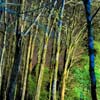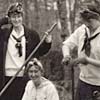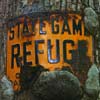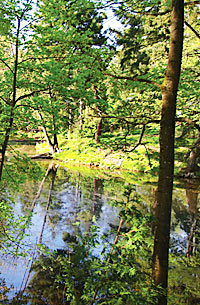History of the Reed Canyon

A place for contemplation, recreation, research, and for a panoply of plants and animals, the 26-acre watershed on the Reed College campus has a recorded history of 95 years. Unrecorded, in our files, is the oral history of water and wind-mixed with the calls of wildlife-that existed centuries before. The story now, as it was then, is that of a life source-but more, a place teeming with life.
Hidden beneath duckweed in summer, or a cap of ice in winter, five-acre Reed Lake is the heart of the canyon. A natural bio spill, the lake continues its long habit of breaking down debris (everything from leaves, manure from a nearby chicken farm, street runoff, and lawn chemicals), thus filtering deposits that would destroy streambeds in Crystal Springs Creek.
 Waterfowl vie for space on the lake, including the Wood Duck, flying up to a tree limb in nesting season; the squeaking American Widgeon; and the Canada Goose, loudly and repeatedly berating intruders. Stand on the cross-canyon bridge in early summer, and be refreshed by the songs of warblers and sparrows from the cool depths of trees and underbrush. Watch the Belted Kingfisher dive for fish-(Prickly Sculpin and Redside Shiner have been observed)-and the Great Blue Heron silently hunting for carp, taking angular and deliberate steps through water and silt.
Waterfowl vie for space on the lake, including the Wood Duck, flying up to a tree limb in nesting season; the squeaking American Widgeon; and the Canada Goose, loudly and repeatedly berating intruders. Stand on the cross-canyon bridge in early summer, and be refreshed by the songs of warblers and sparrows from the cool depths of trees and underbrush. Watch the Belted Kingfisher dive for fish-(Prickly Sculpin and Redside Shiner have been observed)-and the Great Blue Heron silently hunting for carp, taking angular and deliberate steps through water and silt.
Traces of coyote are in evidence in the canyon now, where mammals such as the American Beaver, the Brush Rabbit, and the Vagrant Shrew reside. Owls, swallows, and bats circle above; snakes and salamanders slither below. Nothing is still in this watershed, even when it appears to be.
Under a canopy of Grand Fir, Western Red Cedar, Douglas Fir, Bigleaf Maple, and Red Alder, a visitor might encounter Wild Ginger, Fairybells, Skunk Cabbage, or Bedstraw (which will go with you, even uninvited), or perhaps a Lady's-Nightcap. The canyon has been home to such colorful residents as Nodding Beggar-tic, Stinking Mayweed, Youth-on-Age, and Yellow Touch-Me-Not, but initially, the resident anything was a herd of cows.
As Reed began its association with the land, it was framed by pasture on the north side for the Ladd Estate's Crystal Springs Farm and by planting fields on the south. Douglas Fir constituted the primary plant life (many trees in the original stand of Douglas Fir were destroyed in the 1962 Columbus Day Storm) except at streamside; cows managed to devour or trod upon any other vegetation. In 1910, the Ladd family donated the pasture to the college.
Early ideas for the space included a "picturesque lake" (1912). Reed architect Albert E. Doyle, hoping to continue his design elements from St. John's College, Oxford, proposed "an artful landscape of Tudor Gothic quadrangles and formal gardens" (1913).
 The tradition of Campus Day or Canyon Day began on June 8, 1912. On that day, everyone arrived in formal attire as the cornerstone of the residence hall (Old Dorm Block) was laid. On April 15, 1913, the second Campus Day, community members vigorously downed old fences, removed stumps, and placed at the water's edge the first boathouse-an old Ladd Farm shed, moved from half a mile away. (Eventually there would be two bathhouses, one for women and one for men; a dock; and a diving platform. One bathhouse survived as the bike coop until the 1990s.)
The tradition of Campus Day or Canyon Day began on June 8, 1912. On that day, everyone arrived in formal attire as the cornerstone of the residence hall (Old Dorm Block) was laid. On April 15, 1913, the second Campus Day, community members vigorously downed old fences, removed stumps, and placed at the water's edge the first boathouse-an old Ladd Farm shed, moved from half a mile away. (Eventually there would be two bathhouses, one for women and one for men; a dock; and a diving platform. One bathhouse survived as the bike coop until the 1990s.)
 From 1913 to 1916, the canyon came under the protection of the State of Oregon, from the Fish Commission as a fish hatchery-a small building in the area, approximately where the fish ladder is now, was overseen by Professor Harry B. Torrey-and from the Game Commission as a wildlife refuge.
From 1913 to 1916, the canyon came under the protection of the State of Oregon, from the Fish Commission as a fish hatchery-a small building in the area, approximately where the fish ladder is now, was overseen by Professor Harry B. Torrey-and from the Game Commission as a wildlife refuge.
In 1915, a large section at the west end of Reed Lake was hand-dredged by students to produce an "improved swimming hole," 10 feet deep. (Rumors through the years, fortified by the story of this student effort, led to the supposition that the lake was man made, but surveys have verified that it is the oldest naturally occurring lake in Portland.)
 In 1916, Ambrose Brownell '17 suggested that there be two campus clean-up events annually. The events, which have relied on community momentum during the last 90 years, are fully established currently, to the extent that volunteers introduced 1,000 native plants during the spring 2005 Canyon Day.
In 1916, Ambrose Brownell '17 suggested that there be two campus clean-up events annually. The events, which have relied on community momentum during the last 90 years, are fully established currently, to the extent that volunteers introduced 1,000 native plants during the spring 2005 Canyon Day.
In 1929, a dam was built at the west end of the lake, on the site of a beaver dam, to divert the flow of water and thus provide space for an outdoor swimming pool (built that same year). The dam eventually became a land bridge. The college purchased five additional acres in 1932, granting it full ownership of the canyon ravine.
 The Barry Cerf Memorial Theatre and Garden Area, or amphitheatre, was constructed in 1936, on the southwest corner of the lake, with the aid of the National Youth Administration. Commencement was held there-in good weather-until 1970. Today, the space is used primarily for nature-gazing and theatre productions.
The Barry Cerf Memorial Theatre and Garden Area, or amphitheatre, was constructed in 1936, on the southwest corner of the lake, with the aid of the National Youth Administration. Commencement was held there-in good weather-until 1970. Today, the space is used primarily for nature-gazing and theatre productions.
In 1957, excavation began on the north side of the lake for the cross-canyon dorms, and, by necessity, the flat, wooden bridge from the 1930s was replaced by the first official canyon bridge-the only one of its kind in the world-supported by two cantilevers of pre-stressed plywood and covered with a thin canvas membrane. The Arthur M. Churchill Memorial Bridge was 132 feet long and 15 feet high, and dedicated, along with the residence halls, in 1958. (The architectural firm of Farnham [Neil Farnham '40], Shell & Hoyt designed the bridge.)
The theatre was constructed at the lower streams in the southwest end of the canyon in 1972. On the northeast end, the studio art building was built in 1979. The canyon was recognized as an ecological challenge, a place to preserve and protect, in the 1980s. A reforestation project offset invasive non-native plant species in 1984.
Salmon hatch boxes entered the area in 1990, and the City of Portland joined conservation efforts in 1991, when it brought the canyon under the Johnson Creek Basin Protection Plan and made it part of the Urban Wildlife Refuge System. Construction around the canyon in 1992 included a new, less intrusive cross-canyon bridge, the chemistry building on the east side, and additional residence halls on the north side. The new bridge won the coveted "Excellence in Concrete" award from the American Concrete and Aggregate Producers Association.
By 1994, the college's reactor heat-exchange pipe system, which previously utilized canyon water for cooling, was abandoned. (A closed system and a cooling tower were installed.) The student-run Green Board built a fish box in the canyon in 1996.  The Reed Canyon Enhancement Strategy, developed in 1999, divided the waterway into four zones: the upper, middle, and lower lake areas, and Crystal Springs; and set five-year goals for non-native plant removal and native plant re-vegetation.
The Reed Canyon Enhancement Strategy, developed in 1999, divided the waterway into four zones: the upper, middle, and lower lake areas, and Crystal Springs; and set five-year goals for non-native plant removal and native plant re-vegetation.
In 2000, ecological efforts for the canyon received high marks with the removal of the then-dilapidated outdoor swimming pool. One year later, the fish ladder and stream meander were completed in the same area. And, finally, an abandoned, above-ground 150-foot city water main in the east end of Reed Lake was removed in 2005, restoring the lake's original landscape, and taking the watershed one step closer to its natural beginnings.